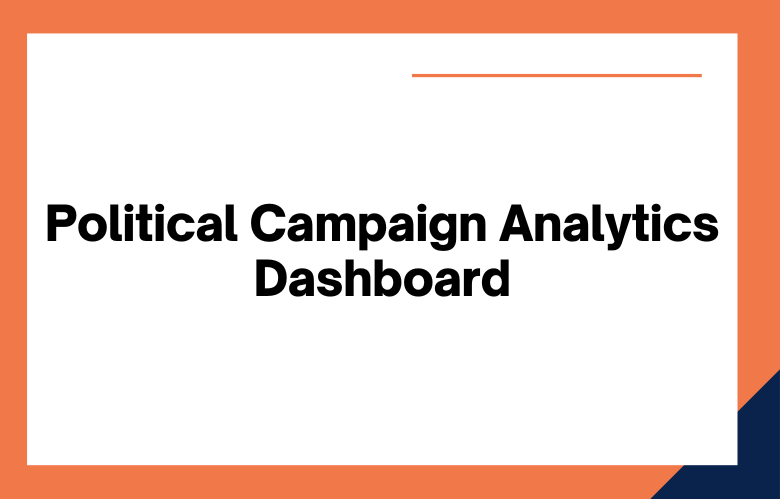Campaigns need analytics dashboards to make the most of their data. With all the available data, it can be hard to know where to start. A good dashboard will help you track important metrics and decide based on your findings.
Here are the analytics dashboards you need for political campaign success.
The world of politics is fast-paced and competitive. If you’re running for office, you must have the right analytics tools to help you make informed decisions and give you an edge over your opponents.
We’ll discuss three essential analytics dashboards that every political campaign should use. Stay ahead of the game with these helpful tools!
Building a successful political campaign requires many things—passionate volunteers, a well-executed strategy, and accurate data, to name a few.
However, one of the essential pieces of any successful campaign is good analytics.
In today’s digital world, it’s more important than ever to access real-time data to help you decide where to allocate your resources.
We’ll explore three essential analytics dashboards that every political campaign should be using.
Stay connected for the next installment in our series on political campaigning- how social media can help you win!
What is an Analytics Dashboard?
An analytics dashboard is a collection of visualizations that provide insights into your data. Dashboards can track KPIs like conversion rate, website traffic, and social media engagement. By monitoring these metrics, you can make decisions that will help improve your business.
An Analytics Dashboard is a powerful tool for tracking your website’s data and performance. By monitoring key metrics, you can identify areas for improvement and make data-driven decisions to improve your website’s overall performance.
An Analytics Dashboard is a tool to track and measure key performance indicators (KPIs) to assess a business’s health. By tracking KPIs, companies can identify areas of improvement and make necessary changes to improve their overall performance.
An Analytics Dashboard is a data visualization tool that allows businesses to track key indicators and performance metrics. It can help managers take a bird’s eye view of company data and make informed decisions about where to allocate resources.
An Analytics Dashboard is a tool that helps you understand your data. It visually represents your data, making it easy to see patterns and trends. Dashboards can include charts, graphs, and other visualizations that help you know what’s essential at a glance.
An analytics dashboard is like a command center for your business data. It helps you make sense of all the numbers and insights your business generates to make better decisions and drive growth by taking necessary actions.
An Analytics Dashboard is a digital display of key performance indicators (KPIs) that allow businesses to track progress and make data-driven decisions. By monitoring and displaying KPIs, companies can gain insights into their most important metrics, identify trends and areas for improvement, and set goals.
An analytics dashboard is a tool businesses use to track and visualize key data metrics. By monitoring these metrics, companies can gain insights into their operations and identify areas for improvement. A well-designed analytics dashboard can help businesses make data-driven decisions and improve performance.
Types of Analytics Dashboards You Need for Political Campaign Success
Without the right metrics, gauging your political campaign’s effectiveness cannot be easy. Traditional methods like polls and focus groups can be time-consuming and expensive. That’s where analytics dashboards come in. The success of your political campaign turns up on the right analytics dashboards. There are a few different types of dashboards you can use to track your campaign’s progress:
Volunteer KPIs:
Please keep track of the number of volunteers you have signed up for, how active they are, and where they live. This information can help you optimize your outreach efforts.
Social Media Dashboard:
A social media dashboard will help you track your campaign’s performance on social media platforms—a social media dashboard to track your campaign’s online presence and engagement.
Email Marketing Dashboard:
An email marketing dashboard will help you track the results of your email marketing campaigns.
Web Traffic Dashboard:
A web traffic dashboard will help you track your campaign website’s traffic.
Donor Management Dashboard:
A donor management dashboard will help track your campaign’s donations and donors.
Event Management Dashboard:
An event management dashboard will help track your campaign’s events and RSVPs. It enables you to track your event attendance and ensure that your events run smoothly.
Data visualization Dashboard:
This type of dashboard transforms complex data sets into easy-to-understand visuals. It helps you quickly identify patterns and trends in your data.
Campaign Performance Dashboard:
This dashboard tracks critical metrics that are important for your campaign. It includes things like fundraising goals, voter engagement, and media coverage.
Issue tracking dashboard:
This dashboard tracks the issues of the Political Campaign. It is an issues dashboard to track public opinion on the issues that matter most to your campaign.
Demographic Dashboard:
A demographic dashboard tracks voter trends by age, race, gender, and location.
Advertising Dashboard:
An advertising dashboard to track your ad campaigns’ reach and effectiveness.
Social Media Analytics Dashboard:
Social media analytics dashboard. It helps you track your social media outreach and see how it affects your overall campaign.
Fundraising Dashboard:
Another dashboard you might need is a fundraising dashboard. It can help you track your fundraising progress and ensure you are on track to reach your goals. You can keep tabs on how much money you’ve raised, from which sources, and how you’re spending it.
You can see your campaign’s progress with the right analytics dashboards. Everything starts with data. But, to make data work for your political campaign, you need to be able to see it clearly and quickly. It is where analytics dashboards come in.
Political Analytics Dashboards Best Practices
- Collect data from different sources
- Clean and organize data for analysis
- Create visualizations to understand the data
- Identify relationships and trends in the data
- Conclude from the data
- Communicate findings to decision-makers
- Understand the basics of data analytics
- Know your target audience
- Choose the right software
- Create custom dashboards
- Filter and analyze data
- Draw insights from data visualizations
- Share insights with stakeholders
- Evaluate performance over time
- Choose the correct type of data visualization
- Make sure your data is accurate
- Use colors and fonts wisely
- Test different designs before settling on one
- Keep your dashboard up-to-date
- Start with your goals
- Choose the correct data
- Create your dashboard structure
- Populate your dashboard with data
- Interpret your data and find trends
- Adjust your dashboard as needed
- Make predictions and recommendations
- Present your findings
- Understand the basics of data analytics
- Create meaningful visualizations
- Filter and clean your data set
- Set up automated dashboards and alerts.
Conclusion
The analytics dashboards you need for political campaign success may vary somewhat from those required for other businesses, but the principles are the same. By understanding your target market and what data is essential to track, you can create a system that gives you the information you need to make informed decisions about your marketing strategy.
Contact us today if you’d like to help set up or improve your analytics dashboard for political/political-marketing-strategy-data-analytics/ campaigns.
With our experience, we are happy to share our insights with you!
Frequently Asked Questions (FAQs)
-
What is an analytics dashboard in a political campaign context?
An analytics dashboard is a visual interface that consolidates key campaign metrics—such as donations, volunteer activity, voter engagement, and media reach—allowing political teams to make informed, data-driven decisions. -
Why are analytics dashboards important for political campaigns?
They provide real-time insights into campaign performance, enabling teams to optimize strategies, improve targeting, and react quickly to trends or challenges. -
Which dashboards are essential for a political campaign?
Core dashboards include Volunteer KPIs, Fundraising, Social Media Analytics, Website Traffic, Email Marketing, Event Management, and Campaign Performance Dashboards. -
What should be tracked in a volunteer KPI dashboard?
Metrics like number of active volunteers, geographic distribution, sign-up growth, and engagement levels help optimize outreach and team mobilization. -
How can a social media dashboard help my campaign?
It helps monitor engagement (likes, shares, comments), follower growth, platform-specific performance, and sentiment analysis for real-time feedback. -
What insights does an email marketing dashboard offer?
It tracks open rates, click-through rates, unsubscribe rates, and conversions from email campaigns to evaluate messaging effectiveness. -
What metrics should a fundraising dashboard track?
Monitor total funds raised, donor frequency, average contribution size, source attribution, and fundraising goals versus actuals. -
How does a web traffic dashboard support campaign growth?
It tracks unique visitors, page views, session duration, bounce rates, and referral sources to assess online engagement. -
What is a campaign performance dashboard?
It aggregates core KPIs across all departments—fundraising, outreach, communications—and provides a high-level overview for leadership. -
Why is a demographic dashboard important?
It helps segment voters by age, gender, location, and ethnicity to better tailor campaign messaging and targeting strategies. -
How can an issue tracking dashboard guide messaging?
By monitoring public opinion and engagement on key issues, campaigns can shape messaging and policy priorities accordingly. -
What is the purpose of an advertising analytics dashboard?
It tracks ad impressions, clicks, conversions, cost-per-acquisition, and ROI across platforms like Google Ads, Facebook, and local media. -
How do data visualization dashboards support decision-making?
By turning complex datasets into easy-to-interpret visuals, they help teams quickly identify patterns, trends, and outliers. -
What tools are commonly used to build political analytics dashboards?
Popular tools include Google Data Studio, Tableau, Power BI, Metabase, and campaign-specific CRMs like NGP VAN or NationBuilder. -
What are best practices for building an effective dashboard?
Start with campaign goals, choose relevant KPIs, clean and filter your data, use intuitive visual formats, and update regularly. -
How do I keep my dashboard relevant over time?
Continuously assess KPIs, remove unused metrics, integrate new data sources, and adapt to evolving campaign phases or goals. -
Can dashboards help with predictive analytics?
Yes. Dashboards can be used alongside predictive models to forecast voter turnout, donation trends, and issue sentiment over time. -
What’s the difference between real-time and historical dashboards?
Real-time dashboards track current data for immediate action, while historical dashboards analyze long-term trends for strategic planning. -
How often should campaign dashboards be reviewed?
Dashboards should be reviewed daily or weekly depending on the metric’s urgency and the campaign’s pace. -
Who should have access to campaign dashboards?
Access should be role-based: leadership views top-level dashboards, while team leads and data analysts use department-specific ones for execution.
One way to get in touch is by filling out our online form on this site or give us a call at
+91 9848321284. Let’s work together today!











